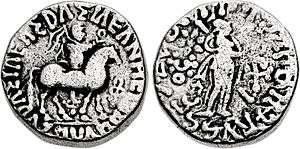Aspavarma

Obv King mounted on a horse, holding a whip. Greek legend around ΒΑΣΙΛΕΩΣ ΒΑΣΙΛΕΩΝ ΜΕΓΑΛΟΥ / ΑΖΟΥ.
Rev Pallas Athena holding spear, and triratna symbol. Kharoshthi legend around Imtravarmaputrasa Aspavarmasa strategasa jayatasa "Victorious general Aspavarma, son of Indravarma".

Aspavarma (or Aspa) was an Indo-Scythian ruler of the clan of the Apraca, who ruled from around 15 to 45 CE. He ruled in the Bajaur area of modern Pakistan, and is considered one of the Apraca rulers. He is essentially known through his coins and a few inscription.
Inscriptions
Asparvama was a son of Apraca king Indravarman, as known from an inscription discovered in Taxila,[1] who himself is known to be the son of Vispavarma according to Indravarman's Silver Reliquary.
Indravarman's Silver Reliquary, which is known for sure to be before the Bajaur casket, hence before 5-6 CE, and is therefore usually dated to the end of the 1st century BCE, describes Aspavarma's grandfather Vispavarma as a general, and not yet a king at that time. This tends to confirm that his grandson, Aspavarma, probably ruled quite some time later, in the middle of the 1st century CE.[2]
Aspavarman is also referenced in Gāndhārī texts, written in Kharoṣṭhī script, dating from the period.[3]
Coinage
The coinage shows the king on a horse, holding a whip in his right hand, in a style consistent with that of Azes II (who possibly is identical with Azes I). On the reverse, Athena makes a benediction gesture, and is flanked by a Buddhist triratna symbol.
According to Joe Cribb, from a coinage standpoint, Aspavarma was contemporary to Sasan and Mujatria, just before the rule of Kushan ruler Vima Takto.[2]
References
- ↑ On the Cusp of an Era: Art in the Pre-Kuṣāṇa World, Doris Srinivasan, BRILL, 2007, p.269-270
- 1 2 Joe Cribb, p.31 Dating and locating Mujatria and the two Kharahostes
- ↑ The British Library Kharosthi Fragments, The British Library/University of Washington Early Buddhist Manuscripts Project.
Indo-Scythian kings, territories and chronology | |||||||||||||||||||||||||||||||||||||||||||||||||||||||||||||||||||||||||||||||||||||||||||||||||||||||||||||||||||||||||||||||||||||||||||||||||||||||||||||||||||||||||||||||||||||||||||||||||||||||||||||||||||||||||||||||||||||
|---|---|---|---|---|---|---|---|---|---|---|---|---|---|---|---|---|---|---|---|---|---|---|---|---|---|---|---|---|---|---|---|---|---|---|---|---|---|---|---|---|---|---|---|---|---|---|---|---|---|---|---|---|---|---|---|---|---|---|---|---|---|---|---|---|---|---|---|---|---|---|---|---|---|---|---|---|---|---|---|---|---|---|---|---|---|---|---|---|---|---|---|---|---|---|---|---|---|---|---|---|---|---|---|---|---|---|---|---|---|---|---|---|---|---|---|---|---|---|---|---|---|---|---|---|---|---|---|---|---|---|---|---|---|---|---|---|---|---|---|---|---|---|---|---|---|---|---|---|---|---|---|---|---|---|---|---|---|---|---|---|---|---|---|---|---|---|---|---|---|---|---|---|---|---|---|---|---|---|---|---|---|---|---|---|---|---|---|---|---|---|---|---|---|---|---|---|---|---|---|---|---|---|---|---|---|---|---|---|---|---|---|---|---|---|---|---|---|---|---|---|---|---|---|---|---|---|---|---|---|
| |||||||||||||||||||||||||||||||||||||||||||||||||||||||||||||||||||||||||||||||||||||||||||||||||||||||||||||||||||||||||||||||||||||||||||||||||||||||||||||||||||||||||||||||||||||||||||||||||||||||||||||||||||||||||||||||||||||
| |||||||||||||||||||||||||||||||||||||||||||||||||||||||||||||||||||||||||||||||||||||||||||||||||||||||||||||||||||||||||||||||||||||||||||||||||||||||||||||||||||||||||||||||||||||||||||||||||||||||||||||||||||||||||||||||||||||